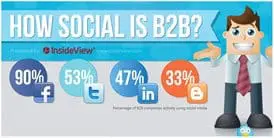[This guest post is by Chris Brogan, President and CEO of Human Business Works. Chris is a publisher, speaker and trainer at chrisbrogan.com. Get his insightful weekly newsletter in your email.]
The Goal: Gain awareness and either a new email list sign-up or a customer.
The Platforms: Blog, email, Twitter, and 1 social network. I’ll use Facebook as my example because you’re probably there.
 1.) Create a post or a page that facilitates the exact conversion you want. If you want more people to download your new song, post your new song, either as a new blog post or as a new page on your website.
1.) Create a post or a page that facilitates the exact conversion you want. If you want more people to download your new song, post your new song, either as a new blog post or as a new page on your website.
Write something that might actually make someone want to do whatever it is you’re asking for. (If you’re doing this on a blog and if you CAN remove the sidebars and other distractions on this post or page, that would be recommended). Make sure that it’s pure or clear whatever your “ask” is going to be, and make that the ONLY option on that post or page. It’s a yes, or it’s a no.
I want you to buy this ____. Click HERE to buy it. That kind of thing.
2.) On Twitter, try writing a tweet that asks a question where the answer would be the solution your selling. “Are you looking for new songs for your summer jam? (add your URL here)”
3.) On your email list, write a message that tells something ELSE about what you wrote on the post or page. If you’re a real estate person listing a house, then write “What I Saw On My Walk Around 149 McGillicuddy Drive,” or if you’re an author, “What didn’t go into Stinky Social Media, my new book.” In both cases, you’re making sure there’s a link back to that page or post.
4.) On Facebook, post to your wall a bit of a story that also ends with your page being the interesting place to visit. Maybe it’s something that spreads: “What Eddie Izzard said when I asked him to read my book.” Maybe it’s just some more information.
You’ll note that we took a slightly (but only somewhat slightly) different approach on each platform, and in all cases, I simply recommended creating some simple content. You could do so much more. You could shoot interviews on YouTube and post them on Google+ or Facebook.
You could invite people to a free webinar that covers the highlights of the thing your selling and then end with the offer, trying to close people within that free webinar (and again in the follow-up email). But generally, that’s what I’m going for.
Some Nuances to Thinking Cross-Platform
In all cases, I’d probably use a mix like this:
- Blog or page
- Email list
- 1 Social Network
Beyond that is just a carpet bombing exercise, and more than likely, you just don’t know where your buyers are. If they are fairly evenly distributed across a lot of platforms then hey, add a second social network. But do your best to never use the same copy or question to reach people on the various platforms. Why? Because if someone follows you on more than one platform, you’re basically inviting them to unfollow you somewhere.
Another nuance: you’ll note that I didn’t say to label your tweet “New Blog Post.” I didn’t tell you to put in your email subject line, “Buy My Monkey.” The goal is to make this receiver-centric. You exist to augment the lives and capabilities of your buyer. Think that way when you create content for them across the various platforms.
Yet another nuance: Twitter isn’t enough, but it’s great for that real-time feeling. If you have a sense of urgency and need to poke people a bit more than normal (like when there are low sales), you can afford to poke people a bit more on Twitter than you can on your email list and definitely more than you can on your blog. It just is. Streams flow.
For instance, you can schedule tweets (I use hootsuite.com to do this) to post the same or similar information every six hours, so that you can reach people in all the random time zones of the world.
One Way to Consider Spacing in a Longer Promotion
If you are promoting something like an event and you have to do so over several days, you might think about a “spacing” method, so that people don’t get sick of you pushing your event. I’ve unfollowed/unsubscribed to several people over this, and I’m in the space! Here are some thoughts.
- On Twitter, it’s probably best to do 12 posts about other people’s items and about non-work items to every “ask.”
- On Facebook, you might post about your ask every 2 days at most.
- On your blog, once a week might be too much, but that’s up to you and your frequency.
- On your email list, I find that writing any more than once a month about your “ask” is a way to trigger several unsubscribes. That’s my experience. Yours may vary.
The Two Stage Sell
Another way to try and up your chances for success is if you invite people to join your email list before you make the full ask. That way, you have the chance to entice people to enjoy your newsletter and then, they may stick around, even if the ask you put before them isn’t really the one they want. Make sense?
How does this compare to your social media startegy? Are you changing up your messaging for your different platforms?





